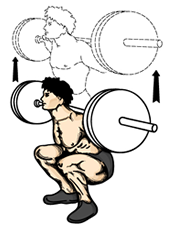Of all the exercises in existence on a seemingly never-ending list, very few come close to the rank of the squat, especially the deep squat. While the shallow squat ends with the knees bent at a 90˚ angle, the deep squat keeps going as low to the ground as possible, and the additional depth can make quite a difference.
Deep squats are commonly regarded as one of the best exercises you can possibly do for the entire body. They help to tone and strengthen a variety of muscles and muscle groups, but they target those in the buttocks (gluteus maximus and minimus) and the thighs (hamstrings and quadriceps) most directly. In addition, deep squats will also increase mobility and flexibility in the hips, ankles and torso, which will help you perform many daily activities and reduce the risk of injury.
Unfortunately, aside from deadlifts, deep squats are probably the most controversial lift out there. As a result, many physical therapists and trainers are told not to allow patients or clients to perform deep squats, as some consider them to be a dangerous lift. The sad truth is that these recommendations are based on old research and misinformation, and deep squats are quite safe so long as they’re performed correctly.
One argument often lobbied against deep squats is that stopping at 90˚—as in shallow squats—mimics the requirements of many common activities, and should therefore be sufficient enough to stop there. What this point overlooks is the fact that deeper squats result in numerous improvements, including greater muscle strength and size, which will in turn lead to better overall performance.
The other major complaint against deep squats is that they increase the chances of knee pain and injury. This belief is based on very dated research, and in actuality, there is no evidence of an association between deep squatting and injury. Patients with damaged knees from injuries in the past should be extra cautious and ensure they’re using proper form when performing deep squats, but this also applies to anyone unfamiliar with the mechanics of a deep squat.
Proper technique is of utmost importance when performing deep squats, and if you’re new to lifting or would simply like some additional assistance with your form, Dynamic Sports Physical Therapy in New York City can help. Contact us at 212-317-8303 for more information on the effectiveness of deep squats or to schedule an appointment.

